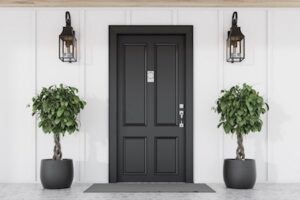How to Maintain Composite Doors in Extreme Weather Conditions
Composite doors have gained immense popularity in the world of home improvement due to their durability, security, and aesthetic appeal. These modern marvels are crafted from a combination of materials, including wood, PVC, and insulating foam. While composite doors offer exceptional performance in various conditions, extreme weather can put them to the test. Whether it’s scorching sunlight, freezing cold, heavy rain, or strong winds, composite doors can be impacted by the elements. In this blog post, we will explore the effects of extreme weather on composite doors and provide valuable insights into how to maintain them to ensure their longevity and functionality. Before delving into the specifics, let’s address a common concern: do composite doors get affected by sunlight? Sunlight, particularly its intense UV rays, can have a significant impact on various materials, including those used in composite doors.

What Are Composite Doors?
Composite doors are advanced and innovative door solutions that combine various materials to create a highly durable and energy-efficient entrance option for homes and buildings. Unlike traditional doors made from a single material, composite doors are constructed by blending elements such as wood, uPVC (unplasticized polyvinyl chloride), glass-reinforced plastic (GRP), and insulating foam. This unique combination of materials results in a door that offers the aesthetic appeal of wood, the strength of metal, and the low maintenance benefits of uPVC. Composite doors are designed to withstand the challenges of changing weather conditions, resist warping, and provide excellent insulation, making them an ideal choice for enhancing both the visual appeal and security of a property.
Effects of Extreme Weather on Composite Doors
Composite doors, renowned for their exceptional durability, can succumb to gradual deterioration when subjected to prolonged bouts of severe weather. This exploration delves into the nuanced impacts of diverse climatic forces on these doors, underscoring the imperative of adept maintenance strategies for upholding their longevity. By understanding the intricate interplay between elemental forces and material integrity, one can proactively safeguard composite doors against weather-induced wear and tear.
How to Maintain Composite Doors in Extreme Weather Conditions:
Composite doors are an investment that requires proper care to ensure they remain functional and visually appealing. By following these expert tips, you can effectively protect your composite doors from the effects of extreme weather:
Sunlight and UV Rays
As mentioned earlier, sunlight can have a substantial impact on composite doors over time. The sun’s UV rays can cause fading and discoloration of the door’s finish, leading to a dull appearance. Moreover, excessive heat from sunlight can potentially warp the door’s components, affecting its overall structure and performance. To mitigate these effects, consider implementing the following measures:
Regular Cleaning: Utilize a mild detergent and water solution to delicately cleanse the door’s surface, ensuring effective removal of dirt and grime. Applying abrasive chemicals should be done with caution because they could make the finish more vulnerable and damage it more.
UV-Protective Coating: Apply a UV-protective coating to the door’s surface. This coating acts as a barrier against harmful UV rays, preventing fading and discoloration.
Adequate Ventilation: Ensure proper ventilation around the door area to prevent excessive heat buildup, which can contribute to warping. Consider installing an awning or shade to provide additional protection.
Extreme Cold
Freezing temperatures can potentially affect the performance of composite doors, particularly if they are not properly maintained. Cold weather can cause the door’s components to contract, leading to issues such as difficulty in opening and closing the door. Here’s how you can address this:
Weather Stripping: Check and replace weather stripping if necessary. Properly sealed weather stripping helps maintain a snug fit and prevents cold drafts from entering your home.
Lubrication: Apply a silicone-based lubricant to the door’s hinges, locks, and handles. This prevents them from freezing or becoming stiff, ensuring smooth operation.
Avoid Slamming: In cold weather, avoid slamming the door, as the sudden impact could damage the door’s structure.
Rain and Moisture
While composite doors are designed to resist moisture, heavy and persistent rain can still pose a challenge. Moisture can seep into gaps or cracks, potentially causing swelling, warping, or even mold growth. To safeguard against these issues:
Inspect and Seal: Regularly inspect the door for any gaps, cracks, or damaged sealant. Repair and seal these areas promptly to prevent moisture infiltration.
Proper Drainage: Ensure that the area around the door has proper drainage to prevent water from pooling. This will help minimize the risk of water damage.
Mold Prevention: Keep the door and surrounding area clean and dry to prevent mold growth. If you notice any signs of mold, clean it using a mild solution of water and vinegar.
Strong Winds
Strong winds can exert pressure on the door, potentially affecting its alignment and operation. Additionally, debris carried by the wind could cause scratches or other forms of damage. To protect your composite door from strong winds:
Reinforce Hardware: Ensure that the door’s hardware, including hinges and locks, is securely fastened. Loose hardware can lead to misalignment during windy conditions.
Trim Surrounding Trees: If there are trees or branches near the door, trim them regularly to prevent them from swaying into the door during windy weather.

Frequently Asked Questions (FAQs)
Can extreme heat cause composite doors to warp?
Yes, prolonged exposure to high temperatures can cause composite doors to warp. Applying a protective finish and avoiding direct sunlight can help prevent this issue.
What should I do if I notice cracks in my composite door?
For minor cracks, you can use a composite repair kit to fill them in. If the cracks are substantial, consider seeking professional assistance for repairs.
Is it necessary to hire a professional for door maintenance?
While basic maintenance can be done by homeowners, consulting a professional is advisable for significant damages or if you’re unsure about the proper maintenance procedures.
Can I use abrasive cleaners to clean my composite door?
No, abrasive cleaners can damage the door’s finish. Use a mild detergent and water for cleaning.
How often should I inspect and clean my composite door?
Regular inspection and cleaning should be done at least twice a year, ideally before extreme weather seasons.
What’s the best way to protect the door during winter?
Keep the door free from snow and ice buildup. Use a plastic shovel to remove snow, and avoid using sharp objects that could scratch the door.
In Closing
Composite doors are a valuable investment for any home, offering a harmonious blend of style and durability. However, they need regular care just like any other part of your house, particularly during severe weather. You can make sure that your composite doors last for many years by following the maintenance advice provided in this article and being aware of the potential impacts of sunlight, cold, rain, and wind on composite doors. Remember that a properly maintained composite door not only improves the curb appeal of your house but also offers you and your family security and comfort.
